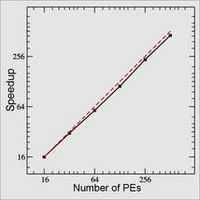Multi-Dimensional Wave Packet Dynamics
Contact
Multi-Dimensional Wave Packet Dynamics
Simulation of Dynamical Processes on Surfaces
For the simulation of dynamical processes on surfaces, such as laser induced desorption, a five dimensional wave packet code (two angular and three cartesian coordinates) has been implemented in our group. This for example enables us to investigate the influence of non-adiabatic effects by propagating multiple coupled wave packets on several highdimensional potential energy surfaces. Other features are the ability to include time dependant external fields like for example laser pulses or the possibility of an asymptotic analysis by applying a grid-change algorithm. The simulation of the dynamics of nuclear motion on our ab initio potential surfaces allows for a first principles mechanistic understanding of experimental results.
A successfull example of the application of wavepacket dynamics in combination with the calculation of potential energy surfaces on an ab-initio basis is the treatment of the NO/NiO system within our group. On the right, the propagation of the nuclear ground state wavepacket on an excited charge transfer state is shown. The inset in the upper right corner shows a corresponding momentum distribution. The bimodal features occuring within this momentum distribution after some instances of time were observed in experiments and could be traced back to the topology of the charge transfer state potential energy surface in this recent theoretical study (Phys. Rev. Lett. 80, 5208 (1998)).
Parallelization of the Wavepacket Code DYN5D

A parallelized version of our wave packet code DYN5D allows the efficient use of massively parallel computers such as a CRAY T3E. The implementation shows an almost linear speedup up to 512 processors and allows calculations up to approximately 1 Billion gridpoints. Recently, four-dimensional stochastic wave packet calculations were performed for the systems CO/Cr2O3(0001) and H2O/TiO2(110) as a great challenge application.
Quantum Dissipation
In close collaboration with R. Kosloff (Jerusalem) we develop a new microscopic approach to include quantum dissipative effects in our wave packet code. An accurate treatment of quantum dissipation is crucial for the description of energy relaxation processes of the intermediate excited state. The idea of a 'surrogate Hamiltonian' is applied to model the influence of a bath of hot electrons on our short lived intermediate. The interplay between dissipative effects and short laser pulses is investigated as well.
